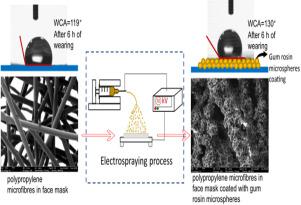Environmental Technology & Innovation ( IF 7.1 ) Pub Date : 2021-07-23 , DOI: 10.1016/j.eti.2021.101812 Cristina Pavon 1 , Miguel Aldas 1, 2 , Emilio Rayón 1 , Marina Patricia Arrieta 3, 4 , Juan López-Martínez 1

|
The present study aims to investigate the effects of gum rosin (GR) microspheres coating over the hydrophobicity of the outer layer of a polypropylene (PP) based surgical face mask. The gum rosin coating was deposited over the surface of the face mask outer layer by electrospraying technique. The deposition of GR microspheres was confirmed by field emission scanning electron microscopy (FESEM) and Fourier transform infrared spectroscopy (FTIR) analysis. The thermal analysis determined a cooperative effect between the microspheres and the mask fibre to increase the maximum degradation rate temperature and the onset degradation temperature. To follow the effect of the GR microspheres coating over the hydrophobicity of the surgical face mask, FESEM and wettability analyses were conducted before and after 3, 6, and 9 h of wearing time. In the FESEM image, it was seen that the microsphere was homogeneously distributed over the nonwoven fibre and its presence increases the roughness of the fibres due to the bulge of microspheres. The wettability measurements suggest that the microspheres coating helps to keep the original hydrophobicity of the outer layer of the surgical face mask even after 6 h of wearing time. Indeed, after 9 h of wearing time, the water contact angle (WCA) of the GR coated face mask is higher than the WCA of the surgical face mask without the coating at 3 h of wearing time. Therefore, the gun rosin microspheres coating improved the hydrophobicity of the surgical face mask which may allow improved protection and/or extended lifetime of use.
中文翻译:

将松香微球沉积在用于口罩的聚丙烯微纤维上以增强其疏水性
本研究旨在研究松香 (GR) 微球涂层对聚丙烯 (PP) 外科口罩外层疏水性的影响。通过电喷涂技术将松香涂层沉积在面罩外层的表面上。通过场发射扫描电子显微镜 (FESEM) 和傅里叶变换红外光谱 (FTIR) 分析证实了 GR 微球的沉积。热分析确定了微球和面罩纤维之间的协同效应,以提高最大降解速率温度和起始降解温度。为了跟踪 GR 微球涂层对外科口罩疏水性的影响,在佩戴时间 3、6 和 9 小时之前和之后进行了 FESEM 和润湿性分析。在 FESEM 图像中,可以看出微球均匀分布在非织造纤维上,由于微球的凸起,微球的存在增加了纤维的粗糙度。润湿性测量表明,即使在佩戴 6 小时后,微球涂层也有助于保持外科口罩外层的原始疏水性。事实上,佩戴 9 小时后,GR 涂层面罩的水接触角 (WCA) 高于佩戴 3 小时时没有涂层的外科口罩的水接触角 (WCA)。因此,枪松香微球涂层改善了外科面罩的疏水性,这可允许改善保护和/或延长使用寿命。可以看出,微球均匀分布在非织造纤维上,由于微球的凸起,微球的存在增加了纤维的粗糙度。润湿性测量表明,即使在佩戴 6 小时后,微球涂层也有助于保持外科口罩外层的原始疏水性。事实上,佩戴 9 小时后,GR 涂层面罩的水接触角 (WCA) 高于佩戴 3 小时时没有涂层的外科口罩的水接触角 (WCA)。因此,枪松香微球涂层改善了外科面罩的疏水性,这可允许改善保护和/或延长使用寿命。可以看出,微球均匀分布在非织造纤维上,由于微球的凸起,微球的存在增加了纤维的粗糙度。润湿性测量表明,即使在佩戴 6 小时后,微球涂层也有助于保持外科口罩外层的原始疏水性。事实上,佩戴 9 小时后,GR 涂层面罩的水接触角 (WCA) 高于佩戴 3 小时时没有涂层的外科口罩的水接触角 (WCA)。因此,枪松香微球涂层改善了外科面罩的疏水性,这可允许改善保护和/或延长使用寿命。润湿性测量表明,即使在佩戴 6 小时后,微球涂层也有助于保持外科口罩外层的原始疏水性。事实上,佩戴 9 小时后,GR 涂层面罩的水接触角 (WCA) 高于佩戴 3 小时时没有涂层的外科口罩的水接触角 (WCA)。因此,枪松香微球涂层改善了外科面罩的疏水性,这可允许改善保护和/或延长使用寿命。润湿性测量表明,即使在佩戴 6 小时后,微球涂层也有助于保持外科口罩外层的原始疏水性。事实上,佩戴 9 小时后,GR 涂层面罩的水接触角 (WCA) 高于佩戴 3 小时时没有涂层的外科口罩的水接触角 (WCA)。因此,枪松香微球涂层改善了外科面罩的疏水性,这可允许改善保护和/或延长使用寿命。



























 京公网安备 11010802027423号
京公网安备 11010802027423号